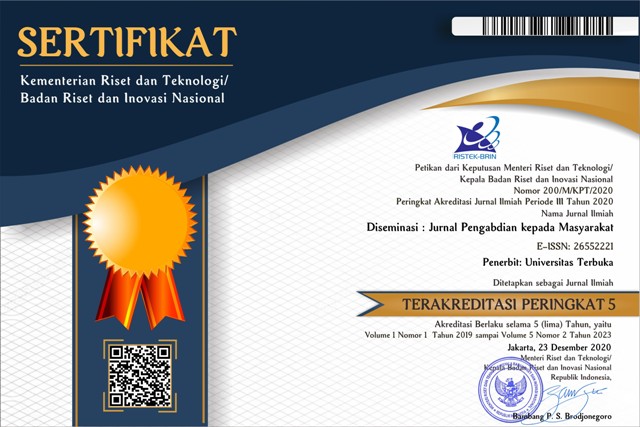APPLICATION OF INTERNET OF THINGS (IOT) TECHNOLOGY TO TRADITIONAL SHRIMP PONDS IN SRIMINOSARI VILLAGE, EAST LAMPUNG
DOI:
https://doi.org/10.33830/diseminasiabdimas.v1i2.526Keywords:
Internet of Things (IoT), Water quality, Shrimp pondAbstract
Traditional shrimp farmers at Sriminosari village still have problem to improve the productivity of their shrimp pond. Based on observation in the field, the low productivity of shrimp pond mainly due to the quality of water pond. Technology of the internet of things (IoT) is an alternative way to monitor some parameter their quality of water such as pH and temperature. Implementation of IoT will give a simple way to monitor the quality of water in a real time and continues. Technically, technology of IoT is not so expensive and easy to used for collecting data of quality water. So it is acceptable to implanted at Sriminosari village and useful to improve productivity shrimp farmer at Sriminosari village. Furthermore, information from IoT data will help farmer shrimp to reduce the risk in their business. Starting from a forum disscussion group (FGD), the technology IoT was introduced to some shrimp farmer at Sriminosari village. In general, The farmer gets basic knowledge about the concept of IoT including the implementation in the field. In this program, parameter pH and temperature was selected as model to monitor water quality of shrimp pond. The result of measurement data temperature on the field showed that an averaged value of temperature relatively stable in normal range 26-33â°C, while the value of pH is various and tend to over the lower limit (< 6.0). Based on collecting data of temperature and pH on the field, it can be concluded that implementing IoT is very useful to assess the quality of water in shrimp farm. Furthermore, the respondents of shrimp farms indicated that implementation IoT in shrimp is acceptable and promising to improve their shrimp farm productivity.
References
Supono, Wardiyanto, Harpeni, E., Khotimah, A. H., Ningtyas, A. (2019) Identification of Vibrio sp. as cause of white feces diseases in white shrimp Penaeus vannamei and handling with herbal ingredients in East Lampung Regency, Indonesia. AACL Bioflux, 12 (2), 417-425.
Encinas, C., Ruiz, E., Cortez, J., Espinoza, A. (2017) Design and implementation of a distributed IoT system for the monitoring of water quality in aquaculture. 978-1-5090-3599-1/17IEEE.
Wyban, J., Walsh, W. A., Godin, D. M. (1995) Temperature effects on growth, feeding rate and feed conversion of the Pacific white shrimp (Penaeus vannamei). Aquaculture, 138, 267-279.
Furtado, P. S., Fugimura, M. M. S., Monserrat, J. M., Souza, D. M., Garcia, L. de O., Wasielesky, W. (2015) Acute effects of extreme pH and its influences on the survival and biochemical biomarkers of juvenile White Shrimp, Litopenaeus vannamei. Marine and Freshwater Behaviour and Physiology. DOI: 10.1080/10236244.2015.1086539.
Downloads
Published
Issue
Section
License
Copyright and Licensing

Diseminasi : Jurnal Pengabdian kepada Masyarakat is licensed under a Creative Commons Attribution-NonCommercial-NoDerivativeWorks 4.0 International License. Allows users to copy and distribute the Article, provided this is not done for commercial purposes and further does not permit distribution of the Article if it is changed or edited in any way, and provided the user gives appropriate credit (with a link to the formal publication through the relevant DOI), provides a link to the license, and that the licensor is not represented as endorsing the use made of the work.















